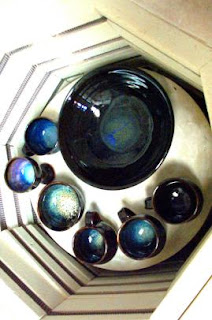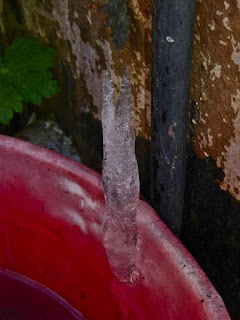Glaze Tests
 I have been doing a series of glaze tests in my electric kiln. The glazes are all from "The Glaze Book" by Stephen Murfitt, published by Thames and Hudson, and I am firing them until cone 11 is down. This useful book was given to me by a thoughtful friend when I turned ?##! on my last birthday. I realized that many of the glazes in the book often share the same base glaze, and I tested 29 glazes that represented 4 main base glazes that looked promising (hope that makes sense??). I thought it would be useful to glaze some bowls with glazes from the same base arranged around the bowl like slices of a pie. This has some merit, as it keeps the group of glazes together in an orderly fashion, and also tests them in a "real life" situation, in stead of just on a small tile. It did make the glazing a bit fiddly to do though.
I have been doing a series of glaze tests in my electric kiln. The glazes are all from "The Glaze Book" by Stephen Murfitt, published by Thames and Hudson, and I am firing them until cone 11 is down. This useful book was given to me by a thoughtful friend when I turned ?##! on my last birthday. I realized that many of the glazes in the book often share the same base glaze, and I tested 29 glazes that represented 4 main base glazes that looked promising (hope that makes sense??). I thought it would be useful to glaze some bowls with glazes from the same base arranged around the bowl like slices of a pie. This has some merit, as it keeps the group of glazes together in an orderly fashion, and also tests them in a "real life" situation, in stead of just on a small tile. It did make the glazing a bit fiddly to do though.


I was quite pleased with the results of the first test, and was quite surprised in some respects as to how like the photos in the glaze book my tests actually were, given that the clay I use, and my raw materials are from different sources.
At first glance, most of the glazes did not look like they would suit the sort of work I do all that well at this present moment, and I felt I would have to develop new forms to show off the glazes to their best, but further thought suggested that the glazes might be interesting in combination with one another, and I did a further firing with a small selection of them with one glaze over another.




Please note that some of the photos of tests that accompany this blog were made by running the wee test bowls through my scanner. Whilst most of the colours are pretty good, there is a rather spectacular light reflection on some of them that sometimes looks like part of the glaze. So you may have to take an educated guess as to how the thing looks in real life.

The green tear drop shape, surrounded by a dark brown glaze was quite arresting in its way. I had painted the green onto the bowl first, then masked it out with wax, before pouring in the dark brown glaze. I particularly liked the honey coloured border between both glazes. Inspired, in a further firing I tried similar things on some rather "below par" mugs that I had thrown whilst rather tired in the post Christmas period.




I also thought that some of the glazes from my first test, particularly ones that contained rutile, might give good chun effects when used over the darker glazes, so I tested these as well. Many of them actually gave a chun effect, some rather similar looking in spite of being rather different glazes. There were two or three that I will probably add to my collection of useful glazes, but the effects were rather too hard to photograph for this blog.

I was pleased with this blue glaze over black glaze bowl.

One surprise from the last set of tests was this brown bowl. I did the radial pattern with wax resist over the dark brown iron glaze that I first poured into the bowl. The top glaze that went over the wax resist was actually a green glaze. I had expected the bowl to turn out green with a simple brown pattern, but the iron glaze turned out to have more of an influence than I thought it would. I rather like how it turned out after the lower glaze bubbled through to the top.


Comments